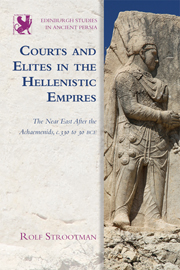Book contents
- Frontmatter
- Contents
- List of Illustrations
- Acknowledgements
- Abbreviations
- The Hellenistic Dynasties
- Series Editor's Preface
- Map
- Introduction: Court and Empire in the Hellenistic Near East
- PART I SETTING THE SCENE
- PART II THE COURT AS A SOCIO-POLITICAL SYSTEM
- PART III CEREMONIAL AND RITUAL
- 9 Ceremonial and Protocol
- 10 Death and Resurrection: Inauguration Ritual
- 11 The Royal Entry
- 12 Royal Processions: Enacting the Myth of Empire
- Conclusion
- Bibliography
- Index
12 - Royal Processions: Enacting the Myth of Empire
from PART III - CEREMONIAL AND RITUAL
Published online by Cambridge University Press: 05 September 2014
- Frontmatter
- Contents
- List of Illustrations
- Acknowledgements
- Abbreviations
- The Hellenistic Dynasties
- Series Editor's Preface
- Map
- Introduction: Court and Empire in the Hellenistic Near East
- PART I SETTING THE SCENE
- PART II THE COURT AS A SOCIO-POLITICAL SYSTEM
- PART III CEREMONIAL AND RITUAL
- 9 Ceremonial and Protocol
- 10 Death and Resurrection: Inauguration Ritual
- 11 The Royal Entry
- 12 Royal Processions: Enacting the Myth of Empire
- Conclusion
- Bibliography
- Index
Summary
In the previous chapter we looked at the ritual arrangement of royals visiting cities. We will now focus on centralised public ritual – the religious festivals and processions that drew people from the periphery to the centre. Whereas in entering particular cities Hellenistic kings played a variety of cultural roles, as we saw in Chapter 11, in centralised public rituals kings assumed a supracultural imperial persona. In the context of the imperial centre, Graeco-Macedonian religious festivals provided a template for the development of new monarchical ritual – a process going back to at least Philip II's imperial festival at Aigai in 336. Of particular importance, especially in the Ptolemaic empire, for the creation of Hellenistic royal pomp were the developing mythology and iconography of Dionysos, the semihuman epiphanic god, whose prestige as conqueror and bringer of peace and joy to the world was manipulated to become a model of kingship closely connected with the Ptolemaic ‘royal gods’ Sarapis and Osiris.
In this chapter the ideological dimensions of monarchical ritual and symbolism will also be evaluated. The main argument will be that the two principal, interconnected, ‘messages’ that were symbolically conveyed in royal rituals were (1) an articulation of the militaristic, heroic nature of the monarchy, and (2) an image of peaceful universal rulership. Here, too, the Ptolemies were able to advance successfully their version of Dionysos. Since the image of Dionysos the conqueror of the east was intrinsically anti-Seleukid, just as he had been an anti-Persian role-model for Alexander, Dionysos was very much a Ptolemaic deity.
- Type
- Chapter
- Information
- Courts and Elites in the Hellenistic EmpiresThe Near East After the Achaemenids, c. 330 to 30 BCE, pp. 247 - 264Publisher: Edinburgh University PressPrint publication year: 2014



